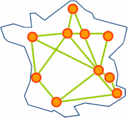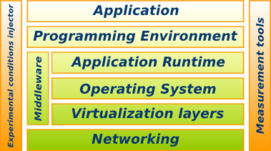Grid5000:Home: Difference between revisions
No edit summary |
No edit summary |
||
| Line 14: | Line 14: | ||
{{#publications:3||**}} | {{#publications:3||**}} | ||
==Latest news== | ==Latest news== | ||
[[Image:SCCampLogo.png|left]] | |||
=== Grid'5000 used as a learning platform during [http://www.sc-camp.org/ SC-Camp 2011] === | |||
[http://www.sc-camp.org SC-Camp] is an initiative of researchers to offer to undergraduate and master students state-of-the-art lectures and programming practical sessions upon High Performance and | |||
Distributed Computing topics. In 2010 the event was in Bucaramanga, Colombia. In 2011 the event will be hosted by Universidad de Costa Rica, Sede del Atlántico en Turrialba. SC-Camp is a non-profit event, composed by 7 days starting on July the 10th of 2011. Of those days 6 are dedicated to scientific lectures, practical programming sessions and a parallel programming contest. | |||
---- | |||
[[Image:Cheat_Sheet_mini.png|left|120px|]] | [[Image:Cheat_Sheet_mini.png|left|120px|]] | ||
=== First [[Media:g5k_cheat_sheet.pdf|Cheat sheet created]] === | === First [[Media:g5k_cheat_sheet.pdf|Cheat sheet created]] === | ||
Revision as of 10:09, 21 June 2011
|
|
Latest updates from Grid'5000 users
- Experiments
{{#experiments:3|||**}}
- Publications
Five random publications that benefited from Grid'5000 (at least 2780 overall):
- Sorina Camarasu-Pop. Computational Reproducibility. 3rd cycle. 12th SLEIGHT Science Event, Saint Etienne (FR), France. 2024. hal-04649287 view on HAL pdf
- Nicolas Hubert, Pierre Monnin, Armelle Brun, Davy Monticolo. Sem@K: Is my knowledge graph embedding model semantic-aware?. Semantic Web – Interoperability, Usability, Applicability, 2023, 14 (6), pp.1273-1309. 10.3233/SW-233508. hal-04344975 view on HAL pdf
- Etienne Delort, Laura Riou, Anukriti Srivastava. Environmental Impact of Artificial Intelligence. INRIA; CEA Leti. 2023, pp.1-33. hal-04283245 view on HAL pdf
- Mateusz Gienieczko, Filip Murlak, Charles Paperman. Supporting Descendants in SIMD-Accelerated JSONPath. International Conference on Architectural Support for Programming Languages and Operating Systems (ASPLOS 2024), 2024, San Diego (California), United States. pp.338-361, 10.4230/LIPIcs. hal-04398350 view on HAL pdf
- Clément Courageux-Sudan. End-to-end simulation of the energy consumption of Fog infrastructures and their applications. Networking and Internet Architecture cs.NI. Université de Rennes, 2023. English. NNT : 2023URENE008. tel-04496167 view on HAL pdf
Latest news
Grid'5000 used as a learning platform during SC-Camp 2011
SC-Camp is an initiative of researchers to offer to undergraduate and master students state-of-the-art lectures and programming practical sessions upon High Performance and Distributed Computing topics. In 2010 the event was in Bucaramanga, Colombia. In 2011 the event will be hosted by Universidad de Costa Rica, Sede del Atlántico en Turrialba. SC-Camp is a non-profit event, composed by 7 days starting on July the 10th of 2011. Of those days 6 are dedicated to scientific lectures, practical programming sessions and a parallel programming contest.
First Cheat sheet created
If you are of those who enjoy a recap of the different commands and links to the main help pages, you'll be pleased to see that an admin has contributed the first Grid'5000 cheat sheet to this wiki. If you wish to understand how it was built, you can read and suggest contributions in the corresponding bug.
Grid'5000 users get 2 out of 3 Best Poster award at IPDPS 2011
Congratulations go to Alexandra Carpen-Amarie ( IRISA, University Rennes 1, INRIA, Rennes, France) for her poster Towards a Self-Adaptive Data Management System for Cloud Environments and to Pierre Riteau (INRIA, IRISA, Rennes, France) for his poster Building Large Scale Dynamic Computing Infrastructures over Distributed Clouds
Grid'5000 at a glance
- Grid'5000 is a scientific instrument for the study of large scale parallel and distributed systems. It aims at providing a highly reconfigurable, controlable and monitorable experimental platform to its users. The initial aim (circa 2003) was to reach 5000 processors in the platform. It has been reframed at 5000 cores, and was reached during winter 2008-2009.
- The infrastructure of Grid'5000 is geographically distributed on different sites hosting the instrument, initially 9 sites in France (10 since 2011). Porto Alegre, Brazil is now officially becoming the first site abroad.
Sites:
- Grid'5000 is a research effort developing a large scale nation wide infrastructure for large scale parallel and distributed computing research.
- 19 laboratories are involved in France with the objective of providing the community a testbed allowing experiments in all the software layers between the network protocols up to the applications.
The current plans are to extend from the 9 initial sites each with 100 to a thousand PCs, connected by the RENATER Education and Research Network to a bigger platform including a few sites outside France not necessarily connected through a dedicated network connection. Sites in Brazil and Luxembourg should join shortly, and Reims has now joined.
All sites in France are connected to RENATER with a 10Gb/s link, except Reims, for the time linked through a 1Gb/s
This high collaborative research effort is funded by INRIA, CNRS, the Universities of all sites and some regional councils.
ALADDIN-G5K : ensuring the development of Grid'5000
For the 2008-2012 period, Engineers ensuring the development and day to day support of the infrastructure are mostly provided by INRIA, under the ADT ALADDIN-G5K initiative.
HEMERA: Demonstrating ambitious up-scaling techniques on Grid'5000
Héméra is an INRIA Large Wingspan project, started in 2010, that aims at demonstrating ambitious up-scaling techniques for large scale distributed computing by carrying out several dimensioning experiments on the Grid’5000 infrastructure, at animating the scientific community around Grid’5000 and at enlarging the Grid’5000 community by helping newcomers to make use of Grid’5000.
Initial Rationale
The foundations of Grid'5000 have emerged from a thorough analysis and numerous discussions about methodologies used for scientific research in the Grid domain. A report presents the rationale for Grid'5000.
In addition to theory, simulators and emulators, there is a strong need for large scale testbeds where real life experimental conditions hold. The size of Grid'5000, in terms of number of sites and number of processors per site, was established according to the scale of the experiments and the number of researchers involved in the project.
Current funding
As from June 2008, INRIA is the main contributor to Grid'5000 funding.
INRIA |
CNRS |
UniversitiesUniversity Joseph Fourier, Grenoble |
Regional councilsAquitaine |







